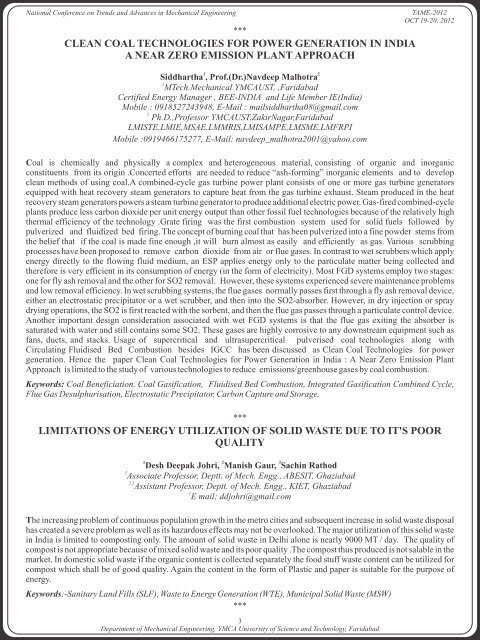Souvenir Containing Abstracts - YMCA University of Science ...
Souvenir Containing Abstracts - YMCA University of Science ...
Souvenir Containing Abstracts - YMCA University of Science ...
You also want an ePaper? Increase the reach of your titles
YUMPU automatically turns print PDFs into web optimized ePapers that Google loves.
National Conference on Trends and Advances in Mechanical Engineering<br />
***<br />
CLEAN COAL TECHNOLOGIES FOR POWER GENERATION IN INDIA<br />
A NEAR ZERO EMISSION PLANT APPROACH<br />
1 2<br />
Siddhartha , Pr<strong>of</strong>.(Dr.)Navdeep Malhotra<br />
1<br />
MTech.Mechanical <strong>YMCA</strong>UST, ,Faridabad<br />
Certified Energy Manager , BEE-INDIA and Life Member IE(India)<br />
Mobile : 0918527243948, E-Mail : mailsiddhartha08@gmail.com<br />
2<br />
Ph.D.,Pr<strong>of</strong>essor <strong>YMCA</strong>UST,ZakirNagar,Faridabad<br />
LMISTE,LMIE,MSAE,LMMRIS,LMISAMPE,LMSME,LMFRPI<br />
Mobile :0919466175277, E-Mail: navdeep_malhotra2001@yahoo.com<br />
Coal is chemically and physically a complex and heterogeneous material, consisting <strong>of</strong> organic and inorganic<br />
constituents from its origin .Concerted efforts are needed to reduce “ash-forming” inorganic elements and to develop<br />
clean methods <strong>of</strong> using coal.A combined-cycle gas turbine power plant consists <strong>of</strong> one or more gas turbine generators<br />
equipped with heat recovery steam generators to capture heat from the gas turbine exhaust. Steam produced in the heat<br />
recovery steam generators powers a steam turbine generator to produce additional electric power. Gas-fired combined-cycle<br />
plants produce less carbon dioxide per unit energy output than other fossil fuel technologies because <strong>of</strong> the relatively high<br />
thermal efficiency <strong>of</strong> the technology .Grate firing was the first combustion system used for solid fuels followed by<br />
pulverized and fluidized bed firing. The concept <strong>of</strong> burning coal that has been pulverized into a fine powder stems from<br />
the belief that if the coal is made fine enough ,it will burn almost as easily and efficiently as gas. Various scrubbing<br />
processes have been proposed to remove carbon dioxide from air or flue gases. In contrast to wet scrubbers which apply<br />
energy directly to the flowing fluid medium, an ESP applies energy only to the particulate matter being collected and<br />
therefore is very efficient in its consumption <strong>of</strong> energy (in the form <strong>of</strong> electricity). Most FGD systems employ two stages:<br />
one for fly ash removal and the other for SO2 removal. However, these systems experienced severe maintenance problems<br />
and low removal efficiency. In wet scrubbing systems, the flue gases normally passes first through a fly ash removal device,<br />
either an electrostatic precipitator or a wet scrubber, and then into the SO2-absorber. However, in dry injection or spray<br />
drying operations, the SO2 is first reacted with the sorbent, and then the flue gas passes through a particulate control device.<br />
Another important design consideration associated with wet FGD systems is that the flue gas exiting the absorber is<br />
saturated with water and still contains some SO2. These gases are highly corrosive to any downstream equipment such as<br />
fans, ducts, and stacks. Usage <strong>of</strong> supercritical and ultrasupercritical pulverised coal technologies along with<br />
Circulating Fluidised Bed Combustion besides IGCC has been discussed as Clean Coal Technologies for power<br />
generation. Hence the paper Clean Coal Technologies for Power Generation in India : A Near Zero Emission Plant<br />
Approach is limited to the study <strong>of</strong> various technologies to reduce emissions/greenhouse gases by coal combustion.<br />
Keywords: Coal Beneficiation, Coal Gasification, Fluidised Bed Combustion, Integrated Gasification Combined Cycle,<br />
Flue Gas Desulphurisation, Electrostatic Precipitator, Carbon Capture and Storage.<br />
***<br />
LIMITATIONS OF ENERGY UTILIZATION OF SOLID WASTE DUE TO IT'S POOR<br />
QUALITY<br />
1 2 3<br />
Desh Deepak Johri, Manish Gaur, Sachin Rathod<br />
1<br />
Associate Pr<strong>of</strong>essor, Deptt. <strong>of</strong> Mech. Engg., ABESIT, Ghaziabad<br />
2,3<br />
Assistant Pr<strong>of</strong>essor, Deptt. <strong>of</strong> Mech. Engg., KIET, Ghaziabad<br />
1<br />
E mail: ddjohri@gmail.com<br />
TAME-2012<br />
OCT 19-20, 2012<br />
The increasing problem <strong>of</strong> continuous population growth in the metro cities and subsequent increase in solid waste disposal<br />
has created a severe problem as well as its hazardous effects may not be overlooked. The major utilization <strong>of</strong> this solid waste<br />
in India is limited to composting only. The amount <strong>of</strong> solid waste in Delhi alone is nearly 9000 MT / day. The quality <strong>of</strong><br />
compost is not appropriate because <strong>of</strong> mixed solid waste and its poor quality .The compost thus produced is not salable in the<br />
market. In domestic solid waste if the organic content is collected separately the food stuff waste content can be utilized for<br />
compost which shall be <strong>of</strong> good quality. Again the content in the form <strong>of</strong> Plastic and paper is suitable for the purpose <strong>of</strong><br />
energy.<br />
Keywords:-Sanitary Land Fills (SLF), Waste to Energy Generation (WTE), Municipal Solid Waste (MSW)<br />
***<br />
3<br />
Department <strong>of</strong> Mechanical Engineering, <strong>YMCA</strong> <strong>University</strong> <strong>of</strong> <strong>Science</strong> and Technology, Faridabad













